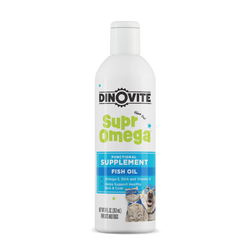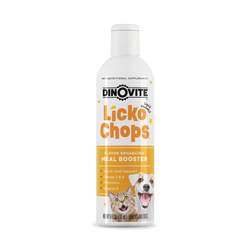Yeast In Cats

Yeast Infection in Cats: How Dinovite Can Help
Yeast in cats is caused by a yeast called Candida albicans. Candida albicans, is an opportunistic yeast, that normally inhabits the body and intestinal tract of our pets (and people as well). The job of Candida albicans in cats, is to recognize and destroy harmful bacteria. In a healthy cat's body, Candida albicans is controlled by a properly-functioning immune system and "friendly" bacteria (gut flora). However, if a cats's immune system is weakened, the number of friendly bacteria decreases and Candida albicans will shift from yeast form (a non-invasive, sugar-fermenting organism) to fungal form. (Invasive, mucosa damaging) - yeast overgrowth begins.
Candida albicans can hit all parts of the cat’s skin and mucous membranes, but humid places are the preferred area.
Symptoms of Yeast
- cat has stinky skin that comes from the inside. Does your cat smell stale?
- cat has goopy, stinky ears. Do you clean and deodorize your cat's ears continually?
- cat has irritated skin, excessive grooming and skin rashes.
- cat has oily fur, flaky skin and brittle coat. Do you hesitate to pet your cat because of what ends up on your hands?
Recipes for Homemade Cat Food?
GO TO : Homemade Cat Food
How does yeast in cats develop? Why does my cat suffer from a yeast infection/overgrowth?
Yeast is present in ALL cats (and humans). A cat's immune system and healthy digestive tract (full of good bacteria) keeps yeast in check. Unfortunately, a cat needs "live" whole foods to keep a strong immune system and digestive tract; but many of these are destroyed in heat processing of food. Some treatments actually create an environment that is conducive to yeast multiplying. This scenario gives yeast the perfect environment to actually thrive!
Yeast Help
- A meaty diet that includes proper nutrition to support immune and digestive health is critical to keeping Candida albicans contained in the digestive tract.
- Diet: Many cat foods are loaded with corn, grains and fillers that actually feed the yeast in cats! Corn or grain based treats, loaded with chemical preservatives and dyes don't help a cat's immune system either. Meaty cat foods with few/no carbs/starches (or make the homemade recipe leaving out the oats,) can prevent feeding Candida albicans and aid the immune and digestive systems so they can fight this issue.
- Treats: Choose meaty cat treats or simply use small pieces of meat (NOT processed meats like deli meats and hot dogs!). NubOnubs are great meaty treats for your cat!
4 Steps to a Happy Cat
- Eliminate or cut way back on the amount of carbohydrates in your cat's diet. Feed a high meat diet. Consider this recipe for Homemade Cat Food.
- Feed nutritious supplements that support immune and digestive tract function; like Dinovite for Cats and LickOchops Omega Fatty Acid Supplement.
- Examine your cat's treats. Toss out anything loaded with grains, fillers, dyes, preservatives and artificial flavoring. Choose meaty treats like NubOnubs treats (no fillers, preservatives, carbs).
Contact Customer Support here!
*All information on this website is for educational purposes only and is not intended to replace the expert advice of a veterinarian or veterinary practitioner.
Related Products



